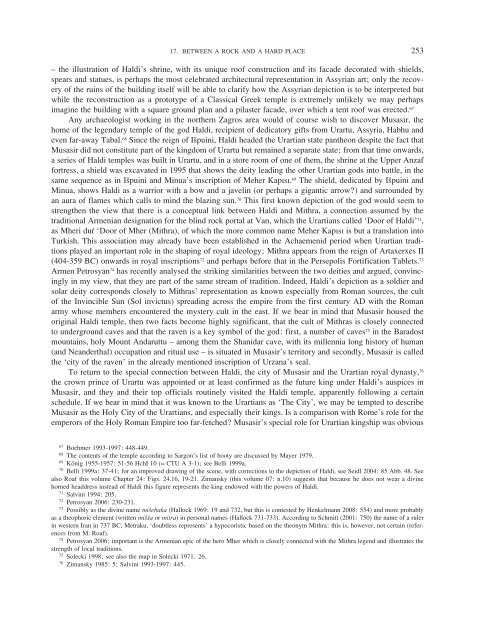Download PDF version of article - UCL
Download PDF version of article - UCL
Download PDF version of article - UCL
Create successful ePaper yourself
Turn your PDF publications into a flip-book with our unique Google optimized e-Paper software.
17. BETWEEN A ROCK AND A HARD PLACE 253<br />
– the illustration <strong>of</strong> Haldi’s shrine, with its unique ro<strong>of</strong> construction and its facade decorated with shields,<br />
spears and statues, is perhaps the most celebrated architectural representation in Assyrian art; only the recovery<br />
<strong>of</strong> the ruins <strong>of</strong> the building itself will be able to clarify how the Assyrian depiction is to be interpreted but<br />
while the reconstruction as a prototype <strong>of</strong> a Classical Greek temple is extremely unlikely we may perhaps<br />
imagine the building with a square ground plan and a pilaster facade, over which a tent ro<strong>of</strong> was erected. 67<br />
Any archaeologist working in the northern Zagros area would <strong>of</strong> course wish to discover Musasir, the<br />
home <strong>of</strong> the legendary temple <strong>of</strong> the god Haldi, recipient <strong>of</strong> dedicatory gifts from Urartu, Assyria, Habhu and<br />
even far-away Tabal. 68 Since the reign <strong>of</strong> Ispuini, Haldi headed the Urartian state pantheon despite the fact that<br />
Musasir did not constitute part <strong>of</strong> the kingdom <strong>of</strong> Urartu but remained a separate state; from that time onwards,<br />
a series <strong>of</strong> Haldi temples was built in Urartu, and in a store room <strong>of</strong> one <strong>of</strong> them, the shrine at the Upper Anzaf<br />
fortress, a shield was excavated in 1995 that shows the deity leading the other Urartian gods into battle, in the<br />
same sequence as in Ispuini and Minua’s inscription <strong>of</strong> Meher Kapısı. 69 The shield, dedicated by Ispuini and<br />
Minua, shows Haldi as a warrior with a bow and a javelin (or perhaps a gigantic arrow?) and surrounded by<br />
an aura <strong>of</strong> flames which calls to mind the blazing sun. 70 This first known depiction <strong>of</strong> the god would seem to<br />
strengthen the view that there is a conceptual link between Haldi and Mithra, a connection assumed by the<br />
traditional Armenian designation for the blind rock portal at Van, which the Urartians called ‘Door <strong>of</strong> Haldi’ 71 ,<br />
as Mheri dur ‘Door <strong>of</strong> Mher (Mithra), <strong>of</strong> which the more common name Meher Kapısı is but a translation into<br />
Turkish. This association may already have been established in the Achaemenid period when Urartian traditions<br />
played an important role in the shaping <strong>of</strong> royal ideology; Mithra appears from the reign <strong>of</strong> Artaxerxes II<br />
(404-359 BC) onwards in royal inscriptions 72 and perhaps before that in the Persepolis Fortification Tablets. 73<br />
Armen Petrosyan 74 has recently analysed the striking similarities between the two deities and argued, convincingly<br />
in my view, that they are part <strong>of</strong> the same stream <strong>of</strong> tradition. Indeed, Haldi’s depiction as a soldier and<br />
solar deity corresponds closely to Mithras’ representation as known especially from Roman sources, the cult<br />
<strong>of</strong> the Invincible Sun (Sol invictus) spreading across the empire from the first century AD with the Roman<br />
army whose members encountered the mystery cult in the east. If we bear in mind that Musasir housed the<br />
original Haldi temple, then two facts become highly significant, that the cult <strong>of</strong> Mithras is closely connected<br />
to underground caves and that the raven is a key symbol <strong>of</strong> the god: first, a number <strong>of</strong> caves 75 in the Baradost<br />
mountains, holy Mount Andaruttu – among them the Shanidar cave, with its millennia long history <strong>of</strong> human<br />
(and Neanderthal) occupation and ritual use – is situated in Musasir’s territory and secondly, Musasir is called<br />
the ‘city <strong>of</strong> the raven’ in the already mentioned inscription <strong>of</strong> Urzana’s seal.<br />
To return to the special connection between Haldi, the city <strong>of</strong> Musasir and the Urartian royal dynasty, 76<br />
the crown prince <strong>of</strong> Urartu was appointed or at least confirmed as the future king under Haldi’s auspices in<br />
Musasir, and they and their top <strong>of</strong>ficials routinely visited the Haldi temple, apparently following a certain<br />
schedule. If we bear in mind that it was known to the Urartians as ‘The City’, we may be tempted to describe<br />
Musasir as the Holy City <strong>of</strong> the Urartians, and especially their kings. Is a comparison with Rome’s role for the<br />
emperors <strong>of</strong> the Holy Roman Empire too far-fetched? Musasir’s special role for Urartian kingship was obvious<br />
67 Boehmer 1993-1997: 448-449.<br />
68 The contents <strong>of</strong> the temple according to Sargon’s list <strong>of</strong> booty are discussed by Mayer 1979.<br />
69 König 1955-1957: 51-56 HchI 10 (= CTU A 3-1); see Belli 1999a.<br />
70 Belli 1999a: 37-41; for an improved drawing <strong>of</strong> the scene, with corrections to the depiction <strong>of</strong> Haldi, see Seidl 2004: 85 Abb. 48. See<br />
also Roaf this volume Chapter 24: Figs. 24.16, 19-21. Zimansky (this volume 07: n.10) suggests that because he does not wear a divine<br />
horned headdress instead <strong>of</strong> Haldi this figure represents the king endowed with the powers <strong>of</strong> Haldi.<br />
71 Salvini 1994: 205.<br />
72 Petrosyan 2006: 230-231.<br />
73 Possibly as the divine name misebaka (Hallock 1969: 19 and 732, but this is contested by Henkelmann 2008: 554) and more probably<br />
as a theophoric element (written missa or mitra) in personal names (Hallock 731-733). According to Schmitt (2001: 750) the name <strong>of</strong> a ruler<br />
in western Iran in 737 BC, Metraku, ‘doubtless represents’ a hypocoristic based on the theonym Mithra: this is, however, not certain (references<br />
from M. Roaf).<br />
74 Petrosyan 2006; important is the Armenian epic <strong>of</strong> the hero Mher which is closely connected with the Mithra legend and illustrates the<br />
strength <strong>of</strong> local traditions.<br />
75 Solecki 1998; see also the map in Solecki 1971: 26.<br />
76 Zimansky 1985: 5; Salvini 1993-1997: 445.

















